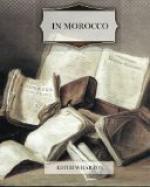[Illustration: From a photograph from the Service des Beaux-Arts au Maroc
Fez Eldjid (the upper city)]
He is undoubtedly on the way, but Fez had not heard of him when we rode out that morning. Fez Eldjid, the “New Fez” of palaces and government buildings, was founded in the fourteenth century by the Merinid princes, and probably looks much as it did then. The palaces in their overgrown gardens, with pale-green trellises dividing the rose-beds from the blue-and-white tiled paths, and fountains in fluted basins of Italian marble, all had the same drowsy charm, yet the oldest were built not more than a century or two ago, others within the last fifty years; and at Marrakech, later in our journey, we were to visit a sumptuous dwelling where plaster-cutters and ceramists from Fez were actually repeating with wonderful skill and spontaneity, the old ornamentation of which the threads run back to Rome and Damascus.
Of really old private dwellings, palaces or rich men’s houses, there are surprisingly few in Morocco. It is hard to guess the age of some of the featureless houses propping each other’s flanks in old Fez or old Sale, but people rich enough to rebuild have always done so, and the passion for building seems allied, in this country of inconsequences, to the supine indifference that lets existing constructions crumble back to clay. “Dust to dust” should have been the motto of the Moroccan palace-builders.
Fez possesses one old secular building, a fine fondak of the fifteenth century, but in Morocco, as a rule, only mosques and the tombs of saints are preserved—none too carefully—and even the strong stone buildings of the Almohads have been allowed to fall to ruin, as at Chella and Rabat. This indifference to the completed object—which is like a kind of collective exaggeration of the artist’s indifference to his completed work—has resulted in the total disappearance of the furniture and works of art which must have filled the beautiful buildings of the Merinid period. Neither pottery nor brasswork nor enamels nor fine hangings survive; there is no parallel in Morocco to the textiles of Syria, the potteries of Persia, the Byzantine ivories or enamels. It has been said that the Moroccan is always a nomad, who lives in his house as if it were a tent; but this is not a conclusive answer to any one who knows the passion of the modern Moroccan for European furniture. When one reads the list of the treasures contained in the palaces of the mediaeval Sultans of Egypt one feels sure that, if artists were lacking in Morocco, the princes and merchants who brought skilled craftsmen across the desert to build their cities must also have imported treasures to adorn them. Yet, as far as is known, the famous fourteenth-century bronze chandelier of Tetuan, and the fine old ritual furniture reported to be contained in certain mosques, are the only important works of art in Morocco later in date than the Roman sloughi of Volubilis.




